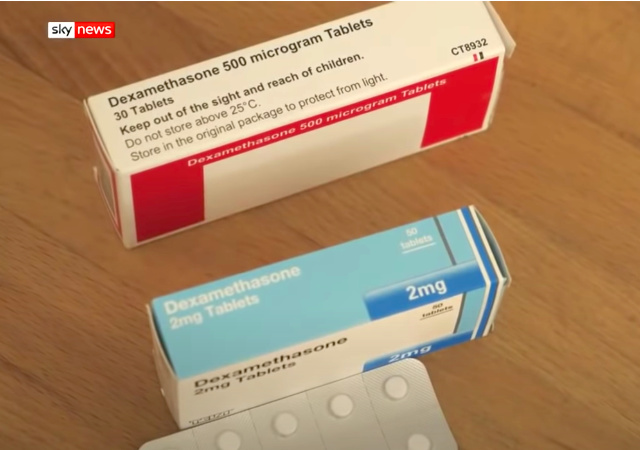Low-Dose Steroid Hailed as Highly Effective Treatment for COVID-19

One of the observations that came out about Wuhan Coronavirus infections is that they lead to inflammation of various tissues.
Therefore, low-dose steroid treatment has been utilized and is now hailed as a highly effective treatment for COVOD-19.
In an unexpected sign of hope amid the expanding pandemic, scientists at the University of Oxford said on Tuesday that an inexpensive and commonly available drug reduced deaths in patients with severe Covid-19, the illness caused by the coronavirus.If the finding is borne out, the drug, a steroid called dexamethasone, would be the first treatment shown to reduce mortality in severely ill patients. Had doctors been using the drug to treat the sickest Covid-19 patients in Britain from the beginning of the pandemic, up to 5,000 deaths could have been prevented, the researchers estimated.In severe cases, the virus directly attacks cells lining the patient’s airways and lungs. But the infection also can prompt an overwhelming immune reaction that is just as harmful. Three-quarters of hospitalized Covid-19 patients receive some form of oxygen.The drug appears to reduce inflammation caused by the immune system, protecting the tissues. In the study, dexamethasone reduced deaths of patients on ventilators by one-third, and deaths of patients on oxygen by one-fifth.
I sure hope President Donald Trump doesn’t tout this one. Otherwise, someone will decide to treat themselves with steroids. Additionally, Food and Drug Administration bureaucrats may choose to make obtaining Dexamethasone for treatment difficult, as they are currently doing with Hydroxychloroquine.
The Food and Drug Administration rescinded the emergency use authorization for hydroxychloroquine to treat hospitalized COVID-19 patients on Monday, saying the drug carries too many risks without any apparent benefit.The authorization was first issued in March, and applied to patients hospitalized with the illness and those in clinical trials. In April, the FDA warned doctors against prescribing the drug to COVID-19 patients outside of those settings. Monday’s action will not affect clinical trials, which are expected to continue.The announcement covers both hydroxychloroquine and a related compound, chloroquine phosphate.
I thought it might be an excellent time to step back and look at trends now, given that many states have reopened (at least partially), and the press is trying to gin-up fears of a second wave. The dreaded “rise in new cases” being reported is not quite what it seems:
The average number of daily new cases has been steadily declining since early April; the average daily deaths, meanwhile, peaked in mid-April and have been dropping ever since.The number of daily cases has shown a slower decline than that of deaths, though much of that may have to do with the number of tests the United States is conducting: since early May the country has recorded anywhere from 300,000 to well over 500,000 new tests per day.
And stories about the “rise in hospitalizations” is based on an incomplete picture as well.
…[A]ccording to the state’s coronavirus dashboard, the number of COVID-19 hospitalizations in Texas has only increased by around 230 over that time, nowhere near enough to account for the increase in total hospitalizations over the past six weeks.A likelier explanation is that Texans have simply been going to the hospital for routine and critical procedures more often. State Gov. Greg Abbot banned elective surgeries in the state in March but began permitting them again in mid-April.In some cases the “spikes” in hospitalizations appear significantly overstated relative to the raw numbers. Fox News this week reported that Montana was among the states that have “seen coronavirus hospitalizations rise by at least 35 percent.” Montana on its COVID-19 dashboard lists a total of seven “active hospitalizations” statewide as of Saturday afternoon.In Florida, meanwhile, the state’s rising number of cases appear to have had little effect on the death rate there. The state’s COVID-19 dashboard displays a modestly upward trend in cases over the last thirty days next to a modestly downward trend in deaths. Cases began a marked upward trend at the beginning of June, but deaths began to sharply drop off at that point, too.
So, as the Trump rally continues to go forward this week, keep the new trends and treatments in mind as the press pushes news about “spikes.”
CLICK HERE FOR FULL VERSION OF THIS STORY